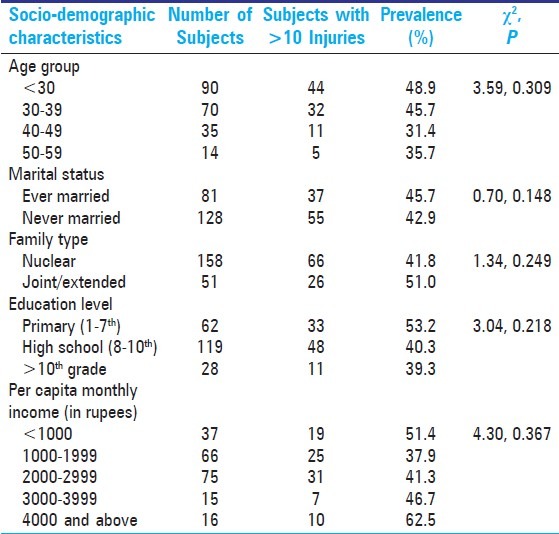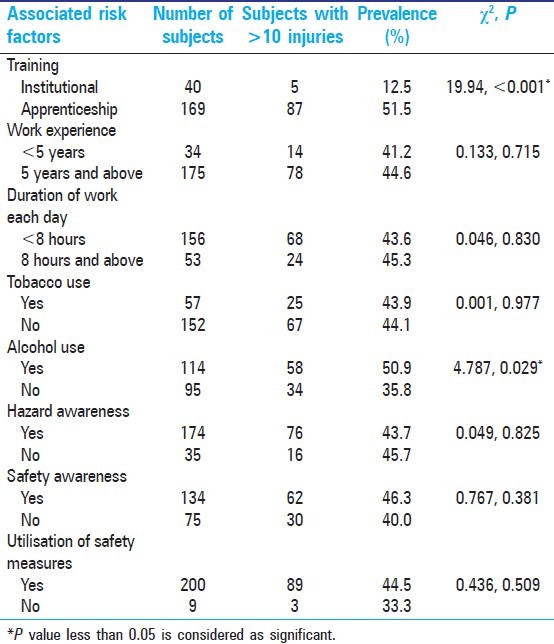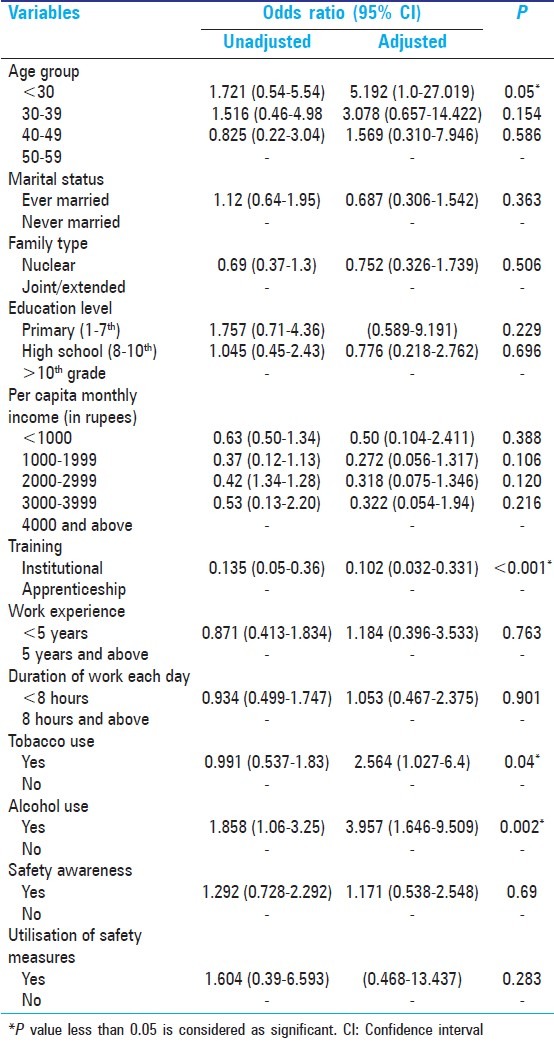Abstract
Background:
Injuries among welders are an important health issue in metal industries at global level. The study aimed to assess the prevalence and pattern of injuries and its possible associated risk factors among welders.
Materials and Methods:
A cross-sectional study was conducted among 209 welders in metal industries of Puducherry, coastal south India. Data regarding all types of injuries during the past 1 year were collected by administering a pre-designed questionnaire. The various risk factors associated with injuries that include age, training before induction, experience, job duration, tobacco chewing, alcohol use and use of protective measures were assessed using standard questionnaire. The data was analyzed by univariate and multiple logistic regression analysis.
Results:
Majority of subjects were aged between 20 and 40 years (160, 76.6%) and educated below 10th standard (181, 86.6%). Mean number of injury was found to be 10.74 (SD = 5.74) in the preceding year. All of them had more than 2 injuries and 44% (92) of them had more than 10 injuries. All of them had abrasions and more than three fourths of them had each of lacerations, foreign body in the eye, flash burns and contusions. Multiple logistic regression analysis showed that age less than 30 years (OR = 5.19), tobacco use (OR = 2.56), alcohol use (OR = 3.96) and institutional training (OR = 0.10) were the predictors associated with more than 10 injuries among welders.
Conclusion:
Injury among welders is an important health problem in this area. Strategies for strengthening institutional training for younger age groups may help in decreasing the burden of injuries.
Keywords: India, occupational injury, prevalence and pattern, welders
INTRODUCTION
More than 350,000 workers lose their lives each year due to unintentional occupational injuries at global level. Occupational injury results from accidents at work place and more than half of this injury burden occurs among men working in the World Health Organization (WHO) South-East Asia and Western Pacific regions.[1] Although the profile of at risk population has changed greatly over the past decade both qualitatively and quantitatively, the risk of occupational injury still centers on workers of various industries.[2] This is because of urbanization and industrialization with labor oriented markets which depends on more automation and mechanization at workplace.[3] Occupational hazards contribute to 2.3% of Disability Adjusted Life Year (DALY) lost among middle income countries and of these welding contributes a significant percentage especially in developing countries like India.[1]
The International Standard Classification of Occupations (ISCO) defines welders and flame cutters as welding and cutting metal parts using gas flame, electric arc and other sources of heat to melt and cut, or to melt and fuse metal.[4] Welders are employed in average numbers of 3 to 5 in private owned small-scale workshops. As they come under the non-organized sector, safety precautions are not strictly implemented. Some of the commonly seen injuries are eye injuries like arc eye or flash burns to cornea, photo keratosis, astigmatism, pingecula, cataract and retinal damage due to exposure to excessive light and ultra violet rays and foreign body injuries to cornea. Inhalation of metal fume causes metal fume fever and pneumonia due to exposure to noxious fumes of zinc, copper, cobalt, nickel, chromium, platinum and their oxides. Other injuries that include accidental cut injuries, amputations; occupational heat stress, thermal burns, electrocution are also common among welders.
In spite of the major public health problem existing among welders, very few studies have been conducted to assess the pattern of all types of injuries and its associated risk factors at global level.[5,6,7] Studies of such nature will give information in developing appropriate prevention methods. There exists no published literature to give us an idea about the magnitude of the problem in this vulnerable group in India. With this background, the study aimed to assess the prevalence of work-related injuries and its associated factors among welders in coastal South India.
MATERIALS AND METHODS
Ethical statement
This study was approved by the ethical committee of the medical institution in Puducherry, India. Subjects were ensured confidentiality and they were explained the purpose and ethical issues involved in the study. Written informed consent was obtained from each subject participating in the study.
Study design and setting
This cross sectional study was conducted among welders in Puducherry, a coastal city in South India. A total of 778 registered metal industries in Puducherry district are spread over 7 commune regions and for the study purpose Puducherry commune region which has got 174 registered metal industries was selected. This region was selected based on feasibility constraints and it will not affect the study outcome because of the comparable socio-demographic and other parameters in these areas. From this area metal industries were selected randomly by using the register number and all the workers in that metal industry were included for our study until our study sample was met.
Sample size estimation
Sample size was estimated by using the formula 4pq/d2, where prevalence ‘p’ was taken as 19% based on previous study[8] and required relative precision of estimate at 30% level. By using the formula, minimum sample size became 190. Considering a non-response error of 10%, final total sample size became 209. All the workers in the randomly selected metal industry with more than 1 year experience were included in the study. If the selected subject does not give consent or could not be able to meet even after two visits, then they are considered as non-respondents.
Data collection procedures
The data was collected by administering a pre designed questionnaire by the investigators based on the lines of guidelines of International Labor Organization.[9] The questionnaire was translated to Tamil language and back translated to English language by independent experts to retain the reliability of the instrument. It was pretested and necessary modifications were made according to field conditions.
The subjects were interviewed in person by the investigators at their work place according to pre scheduled time table. Baseline data was collected regarding socio-demographic variables that include age, education, marital status and monthly income. Data regarding all types of injuries related to occupation during the past 1 year at work place that include mechanical injuries, arc eye injuries, foreign body in the eye, retinal damage, burns, electrical injury and occupational diseases or hazards like back ache or waist pain, hearing impairment, pingecula, pterygium, metal fume fever and pneumonia were collected based on history and or previous diagnosis by registered medical practitioner.
We have considered the presence of any type of occupational injuries to look for possible association of various factors with it that include age, training before induction, experience, job duration, tobacco chewing, alcohol use, awareness and use of protective measures were assessed. Current tobacco users were those who use any form of tobacco product at least once daily and alcohol user was defined as a person who consumed any amount of alcohol at least once in a week.[10]
Statistical analysis
The collected data was entered in Statistical Package for Social Sciences (SPSS) version 16 for windows. Data was analyzed and expressed in terms of proportion and percentages. Univariate and multivariate analyses were done to find out the possible association between number of injuries and associated factors. A P < 0.05 is considered as significant.
RESULTS
All 209 welders participated in the study and they were all males. Majority of them were aged 20 to 40 years (160, 76.6%), educated below 10th standard (181, 86.6%) and their per capita income was below 3000 rupees (178, 85.2%). Mean number of injury was found to be 10.74 (SD = 5.74) in the preceding year. All of them had abrasions and more than — of them had lacerations, foreign body in the eye, flash burns and contusions. Majority of them had more than 2 injuries (97.1%, 203) and 44% (92) of them had more than 10 injuries. No one reported pneumonia, retinal damage and amputation. About 66.5% (139) had occupational diseases or hazards like waist or back pain and 27.8% (58) had hearing impairment [Table 1].
Table 1.
Type of occupational injuries and diseases among the welders

The majority of them had more than 5 years experience (175, 83.7%) and were working less than 8 hours each day (156, 74.6%), but only 1/5 of them had institutional training (40,19.1%). About one quarter of them were using tobacco (57, 27.3%) and about half of them were using alcohol (114, 54.5%). Prevalence was comparatively higher among less than 30 years age group (48.9%) and in the group with education between 1st and 7th grade (53.2%) [Table 2].
Table 2.
Pattern of injury according to socio-demographic characteristics

Prevalence was found to be comparatively higher among those who did not have institutional training and use alcohol; and both the above factors were found to be significantly associated with more than 10 injuries in univariate analysis [Table 3]. Multiple logistic regression analysis showed that age less than 30 years (OR = 5.19), tobacco use (OR = 2.56), alcohol use (OR = 3.96) and institutional training (OR = 0.10) were independently associated with more than 10 injuries [Table 4].
Table 3.
Pattern of injury according to associated risk factors: Univariate analysis

Table 4.
Correlates of injuries among welders: Multiple logistic regression analysis

DISCUSSION
Well-documented studies to determine the epidemiology of injuries among welders at work place are very few at global level. But there are some other studies done among workers of other industries in India.[11,12] The fact that majority of them had more than 2 injuries and proportion of those with more than 10 injuries is 44% in the previous year is a matter of concern. A recent study in a metal smelting industry in India reported that incidence rate of injuries varied from 40.7 to 85.8 per thousand exposed workers.[13] Adopting health promotional measures at workplace is an important measure to prevent injuries.[14] Our study gives valuable information regarding the burden and associated risk factors of injury among welders in this part of the country, which can be used by the concerned authorities to develop appropriate interventional measures.
A recent study from Nigeria showed that 85.3% of the welders had at least one injury in the preceding year.[6] Another study found that 105 injuries were reported by 61 welders out of 208 welders in the past 6 months.[5] A study done in Pakistan showed that 18.7% welders reported an injury in the past 3 months, while 30.3% welders reported sustaining an injury in the past twelve months.[8] The difference in injuries reported in various countries may be due to the difference in methodology adopted, socio-cultural and regulatory factors adopted by concerned states. The most common injuries sustained in our study were abrasions, lacerations, contusions and eye injuries which are comparatively more than other studies. Also, around half of them had afflicted with each condition of waist/back pain, burns and metal fume fever. Back pain was found to be commonly associated with welders.[15] This is in spite of the fact that majority of them were working for less than 8 hours a day and were aware regarding this hazard. Our study highlighted the fact that predictors of injury includes age less than 30 years, alcohol use, tobacco use and lack of institutional training. A recent study showed that injury is more common among younger age group and those without training.[11] In view of the above finding, it is suggested that adopting the sustainable behavioral change practices for the prevention of injuries through training and adoption of personal protective measures is an important step to be considered.
Nearly half of the subjects belonged to age group of less than 30 years (43%, 90). They are five times higher at risk of developing more than 10 injuries as compared to the above 50 years age group. This may be probably due to less working efficiency in younger age group. Also, majority of them did not had institutional training. Other studies also found similar findings.[6,7] Injuries were noted only in males in this study because only males were employed and this is likely to be due to the fact that welding employs males commonly in this region. All the study participants were literate in contrast to Nigerian study which reported 7.6% illiterates.[6] Although literacy will help in understanding of basic safety measures, here we did not find any association. This may be because of lack of awareness to safety measures (36%, 75) and utilization of all relevant safety measures during working hours. Besides, majority (80.9%) of welders received their training through apprenticeship training.
One of the important injuries among welders in our study is the flash injury called the arc eye. This causes a red eye with feeling of sands in the eye due to inflammation. Eye injuries occur most frequently in metal-work industries and cold particles, most often metal are the most common source of injury.[16] A study done in the USA found that eye injuries accounted for 25% of all claims for welders. Subjects were mainly males (97.1%) and from manufacturing (70.4%), service (11.8%), or construction (8.4%)-related industries. Most injuries reported in another study were foreign body in the eye (71.7%) or burns (22.2%) which were comparatively lesser than our study.[17] The commonest ocular injury was metallic foreign body followed by photo keratitis and conjunctivitis in this study and three fourth (76.5%) of them were aged below 40 years; and these results are comparable to another study.[18] About one fourth of subjects had hearing impairment in this study, while it was 7% in another study.[6]
Limitations
The cross sectional study nature and recall bias are the limitations of the study. Because of feasibility constraints, we could not include the welders working outside the Puducherry city area. We could not analyze the quantification of certain factors like alcohol and tobacco use. Longitudinal studies will be required to look further into the role of associated factors of injury among welders.
CONCLUSION
Injury among welders is an important public health problem in this area, in the context of high prevalence rate and larger involvement of at risk worker population in welding metal industries. Strategies for reducing the tobacco and alcohol use and strengthening of institutional training especially for younger age groups may help in decreasing the burden of injuries in this vulnerable group.
ACKNOWLEDGEMENT
The project was a part of Indian Council of Medical Research under short term studentship (ICMR STS for the year 2011) project. We thank the subjects participated in the study.
Footnotes
Source of Support: Nil
Conflict of Interest: None declared.
REFERENCES
- 1.World Health Organisation. Global Health Risks, Mortality and Burden of diseases attributable to major health risks. Geneva: WHO; 2009. [Last accessed on 2011 Sept 22]. Available from: http://www.who.int/healthinfo/global_burden_disease/GlobalHealthRisks_report_full.pdf . [Google Scholar]
- 2.Benavides FG, Delclos J, Benach J, Serra C. Occupational injury, A public health priority. Rev Esp Salud Publica. 2006;80:553–65. doi: 10.1590/s1135-57272006000500011. [DOI] [PubMed] [Google Scholar]
- 3.Agnihotram RV. An overview of occupational health research in India. Indian J Occup Environ Med. 2005;9:10–4. [Google Scholar]
- 4.International Labor Organisation. Updating the International Standard Classifications of occupations. ILO: Department of Statistics; 2008. [Last accessed on 2011 Sept 20]. Available from: http://www.ilo.org/public/english/bureau/stat/isco/docs/d5b.pdf . [Google Scholar]
- 5.Shaikh MA, Shaikh IA. Occupational injuries in welders--results from a six month follow-up study. J Ayub Med Coll Abbottabad. 2005;17:9–11. [PubMed] [Google Scholar]
- 6.Sabitu K, Iliyasu Z, Dauda MM. Awareness of occupational hazards and utilization of safety measures among welders in Kaduna metropolis, Northern Nigeria. Ann Afr Med. 2009;1:46–51. doi: 10.4103/1596-3519.55764. [DOI] [PubMed] [Google Scholar]
- 7.Isah EC, Okojie OH. Occupational health problems of welders in Benin City, Nigeria. J Med Biomed Res. 2006;5:64–9. [Google Scholar]
- 8.Shaikh MA. Hazard perception and occupational injuries in the welders and lathe machine operators of Rawalpindi and Islamabad. J Pak Med Assoc. 2001;51:71–4. [PubMed] [Google Scholar]
- 9.Brancoli M. Encyclopaedia of Occupational Health and Safty. 13th ed. Geneva: International Labour Organization (ILO); 1983. Accident statistics. In: International Labor Office; pp. 32–5. [Google Scholar]
- 10.Chobanian AV, Bakris GL, Black HR, Cushman WC, Green LA, Izzo JL, Jr, et al. The Seventh Report of the Joint National Committee on Prevention, Detection, Evaluation, and Treatment of High Blood Pressure: The JNC 7 Report. JAMA. 2003;289:2573–5. doi: 10.1001/jama.289.19.2560. [DOI] [PubMed] [Google Scholar]
- 11.Kumar SG, Rathnakar U, Harsha Kumar H. Epidemiology of accidents in tile factories of Mangalore city in Karnataka. Indian J Community Med. 2010;35:78–81. doi: 10.4103/0970-0218.62567. [DOI] [PMC free article] [PubMed] [Google Scholar]
- 12.Calvin S, Joseph B. Occupational related accidents in selected garment industries in Bangalore city. Indian J Community Med. 2006;31:151–2. [Google Scholar]
- 13.Saha A, Kumar S, Vasudevan DM. Occupational injury surveillance: A study in a metal smelting industry. Indian J Occup Environ Med. 2007;11:103–07. doi: 10.4103/0019-5278.38458. [DOI] [PMC free article] [PubMed] [Google Scholar]
- 14.Kumar SG. Issues related to health promotional measures at workplace. Int J Occup Saf Health. 2011;1:5–6. [Google Scholar]
- 15.Vieira ER, Kumar S, Narayan Y. Smoking, no-exercise, overweight and low back disorder in welders and nurses. Int J Ind Ergon. 2008;38:143–9. [Google Scholar]
- 16.Reesal MR, Dufresne RM, Suggett D, Alleyne BC. Welder eye injuries. J Occup Med. 1989;31:1003–6. doi: 10.1097/00043764-198912000-00014. [DOI] [PubMed] [Google Scholar]
- 17.Lombardi DA, Pannala R, Sorock GS, Wellman H, Courtney TK, Verma S, et al. Welding related occupational eye injuries: A narrative analysis. Inj Prev. 2005;11:174–9. doi: 10.1136/ip.2004.007088. [DOI] [PMC free article] [PubMed] [Google Scholar]
- 18.Fiebai B, Awoyesuku EA. Ocular injuries among industrial welders in Port Harcourt, Nigeria. Clin Ophthalmol. 2011;5:1261–3. doi: 10.2147/OPTH.S20297. [DOI] [PMC free article] [PubMed] [Google Scholar]


